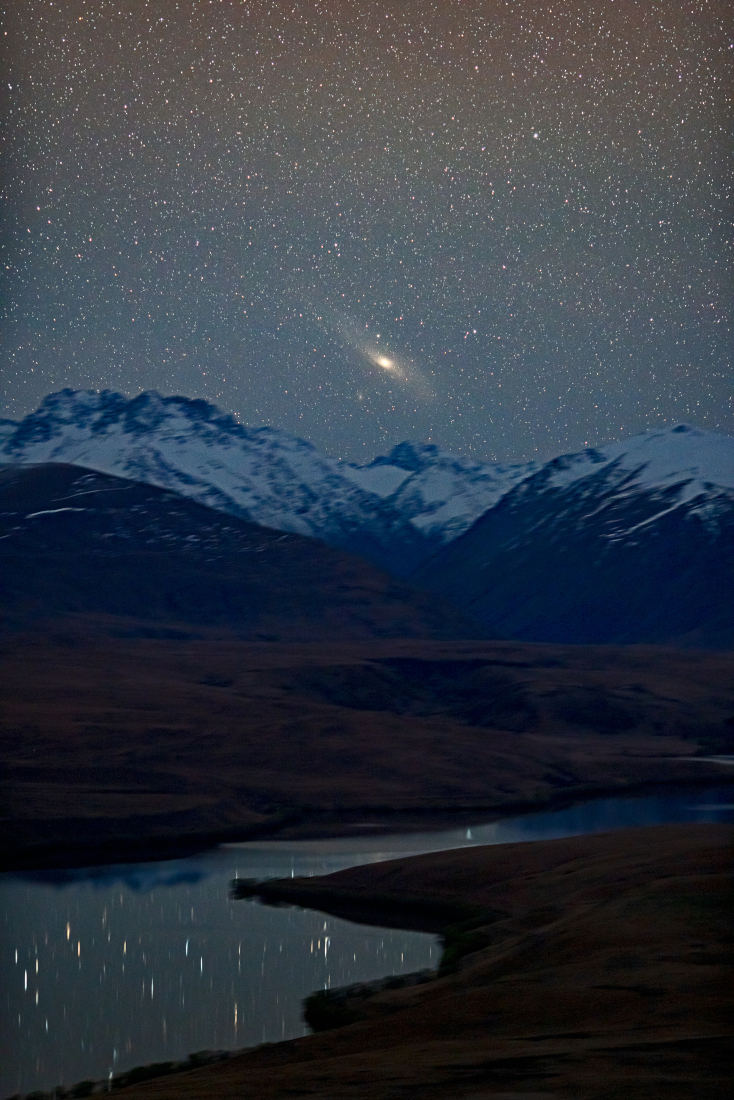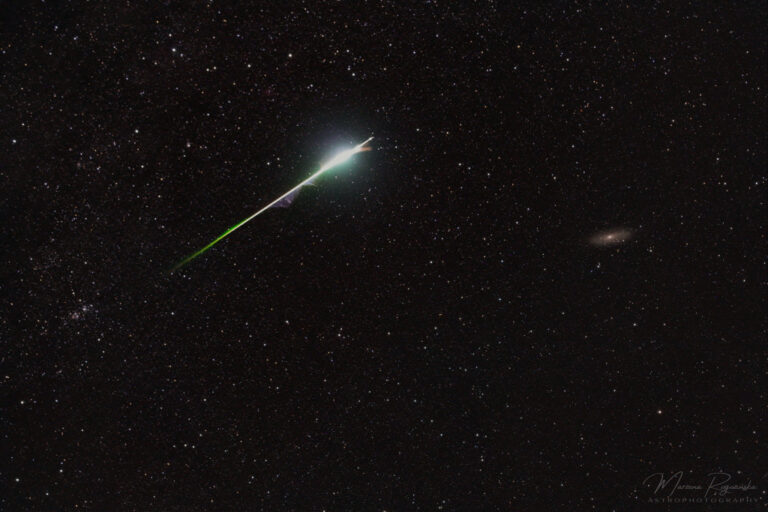哈勃影像: 仙女座星系的拼接图
See Explanation. Clicking on the picture will download the highest resolution version available.
请参阅说明。单击图片将下载可用的最高分辨率版本。

See Explanation. Clicking on the picture will download the highest resolution version available.
请参阅说明。单击图片将下载可用的最高分辨率版本。

The featured image shows a spiral galaxy and a smaller oval galaxy in a dark starfield. Please see the explanation for more detailed information.
特色图片展示了黑暗星场中的一个螺旋星系和一个较小的椭圆星系。有关更多详细信息,请参阅说明。

2023年11月13日 Andromeda over the Alps Image Credit & Copyright: Dzmitry Kananovich Explanation: Have you ever seen the Andromeda galaxy? Although M31 appears as a faint and fuzzy blob to the unaided eye, the light you see will be over two million years old, making it likely the oldest light you ever will see directly. The featured image captured Andromeda just before it set behind the Swiss Alps early last year. As cool as it may be to see this neighboring galaxy to our Milky Way with your own eyes, long duration camera exposures can pick up many faint and breathtaking details. The image is composite of foreground and background images taken consecutively with the same camera and from the same location. Recent data indicate that…

2022年10月21日 Andromeda in Southern Skies Image Credit & Copyright: Ian Griffin (Otago Museum) Explanation: Looking north from southern New Zealand, the Andromeda Galaxy never gets more than about five degrees above the horizon. As spring comes to the southern hemisphere, in late September Andromeda is highest in the sky around midnight though. In a single 30 second exposure this telephoto image tracked the stars to capture the closest large spiral galaxy from Mount John Observatory as it climbed just over the rugged peaks of the south island’s Southern Alps. In the foreground, stars are reflected in the still waters of Lake Alexandrina. Also known as M31, the Andromeda Galaxy is one of the brightest objects in the Messier catalog, usually visible to the unaided eye…

2021年8月14日 Island Universe, Cosmic Sand Image Credit & Copyright: Marzena Rogozinska Explanation: Stars in our own Milky Way Galaxy are scattered through this eye-catching field of view. From the early hours after midnight on August 13, the 30 second exposure of the night sky over Busko-Zdroj, Poland records the colorful and bright trail of a Perseid meteor. Seen near the peak of the annual Perseid meteor shower it flashes from lower left to upper right. The hurtling grain of cosmic sand, a piece of dust from periodic comet Swift-Tuttle, vaporized as it passed through planet Earth’s atmosphere at almost 60 kilometers per second. Just above and right of center, well beyond the stars of the Milky Way, lies the island universe known as M31 or…

2021年06月25日 Andromeda in a Single Shot Image Credit & Copyright: Miguel Claro (TWAN, Dark Sky Alqueva) Explanation: How far can you see? The Andromeda Galaxy, 2.5 million light years away, is the most distant object easily seen by the unaided eye. Other denizens of the night sky, like stars, clusters, and nebulae, are typically hundreds to thousands of light-years distant. That’s far beyond the Solar System but well within our own Milky Way Galaxy. Also known as M31, the external galaxy poses directly above a chimney in this well-planned deep night skyscape from an old mine in southern Portugal. The image was captured in a single exposure tracking the sky, so the foreground is slightly blurred by the camera’s motion while Andromeda itself looms large….

2020年10月13日 Mars, Pleiades, and Andromeda over Stone Lions Image Credit & Copyright: Cem Özkeser Explanation: Three very different — and very famous — objects were all captured in a single frame last month. On the upper left is the bright blue Pleiades, perhaps the most famous cluster of stars on the night sky. The Pleiades (M45) is about 450 light years away and easily found a few degrees from Orion. On the upper right is the expansive Andromeda Galaxy, perhaps the most famous galaxy — external to our own — on the night sky. Andromeda (M31) is one of few objects visible to the unaided eye where you can see light that is millions of years old. In the middle is bright red Mars, perhaps…

2020 May 1 A View Toward M106 Image Credit & Copyright: Joonhwa Lee Explanation: Big, bright, beautiful spiral, Messier 106 dominates this cosmic vista. The nearly two degree wide telescopic field of view looks toward the well-trained constellation Canes Venatici, near the handle of the Big Dipper. Also known as NGC 4258, M106 is about 80,000 light-years across and 23.5 million light-years away, the largest member of the Canes II galaxy group. For a far far away galaxy, the distance to M106 is well-known in part because it can be directly measured by tracking this galaxy’s remarkable maser, or microwave laser emission. Very rare but naturally occurring, the maser emission is produced by water molecules in molecular clouds orbiting its active galactic nucleus. Another prominent…

2020 April 30 Andromeda Island Universe Image Credit & Copyright: Yuzhe Xiao Explanation: The most distant object easily visible to the unaided eye is M31, the great Andromeda Galaxy some two and a half million light-years away. But without a telescope, even this immense spiral galaxy – spanning over 200,000 light years – appears as a faint, nebulous cloud in the constellation Andromeda. In contrast, a bright yellow nucleus, dark winding dust lanes, expansive blue spiral arms and star clusters are recorded in this stunning telescopic image. While even casual skygazers are now inspired by the knowledge that there are many distant galaxies like M31, astronomers debated this fundamental concept 100 years ago. Were these “spiral nebulae” simply outlying components of our own Milky Way…

2020 March 26 Andromeda Station Composite Image Credit & Copyright: Ralf Rohner Explanation: This surreal picture isn’t from a special effects sci-fi movie. It is a digital composite of frames of the real Andromeda Galaxy, also known as M31, rising over a real mountain. Exposures tracking the galaxy and background stars have been digitally combined with separate exposures of the foreground terrain. All background and foreground exposures were made back to back with the same camera and telephoto lens on the same night from the same location. In the “Deepscape” combination they produce a stunning image that reveals a range of brightness and color that your eye can’t quite see on its own. Still, it does look like you could ride a cable car up…